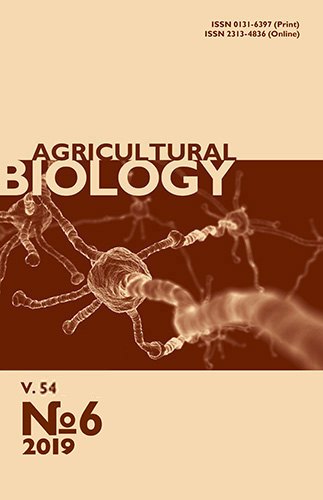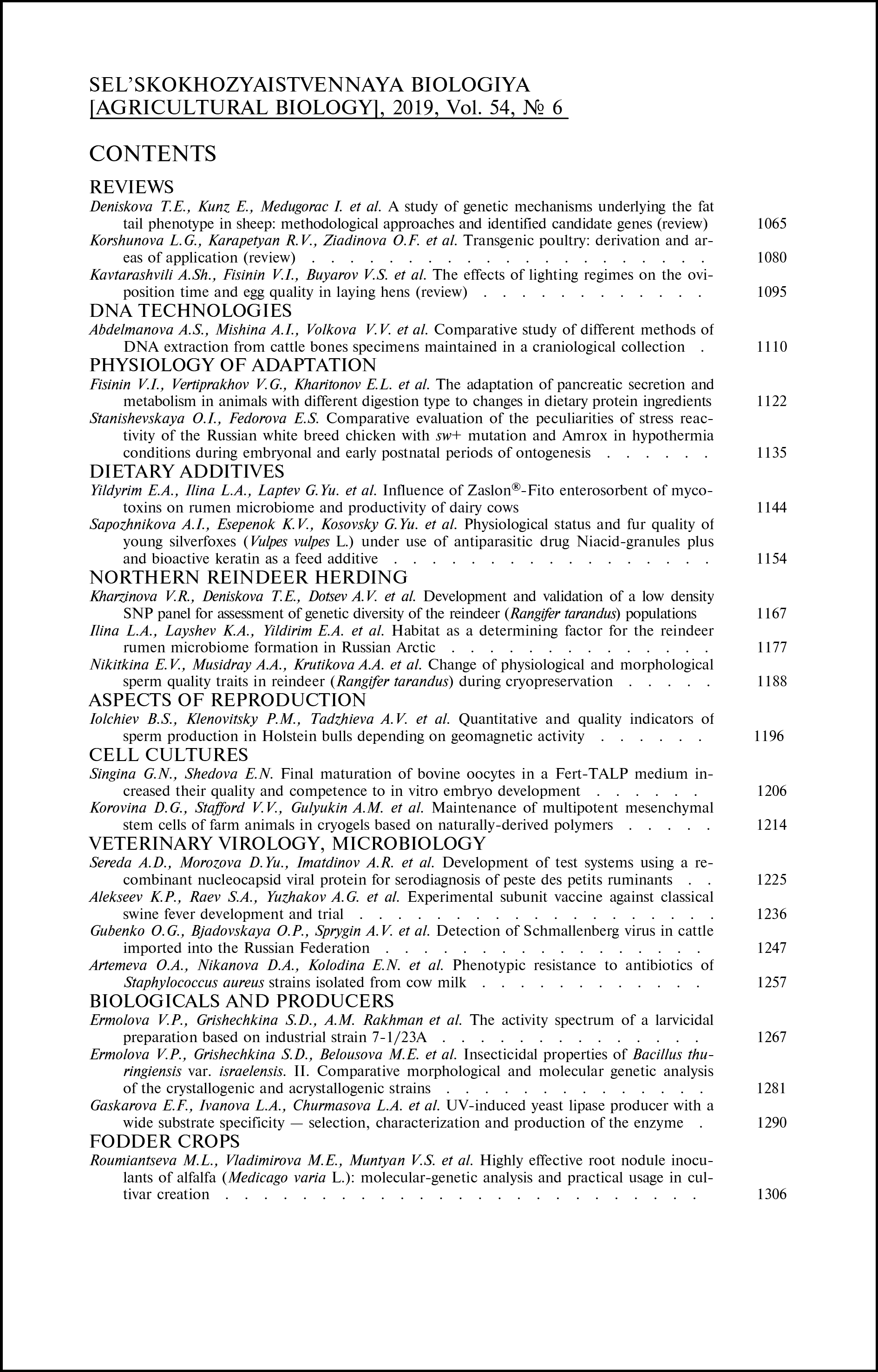doi: 10.15389/agrobiology.2019.6.1135eng
UDC: 636.52/.58:636.018
Acknowledgements:
The work has been carried out under the State Task АААА-А18-118021590129-9.
COMPARATIVE EVALUATION OF THE PECULIARITIES OF STRESS REACTIVITY OF THE RUSSIAN WHITE BREED CHICKEN WITH sw+ MUTATION AND AMROX IN HYPOTHERMIA CONDITIONS DURING EMBRYONAL AND EARLY POSTNATAL PERIODS OF ONTOGENESIS
O.I. Stanishevskaya, E.S. Fedorova
All-Russian Research Institute for Farm Animal Genetics and Breeding — Branch of Ernst Federal Science Center for Animal Husbandry, 55А, Moskovskoe sh., pos. Tyarlevo, St. Petersburg—Pushkin, 196625 Russia, e-mail olgastan@list.ru (✉ corresponding author), Fedorova816@mail.ru
ORCID:
Stanishevskaya O.I. orcid.org/0000-0001-9504-3916
Fedorova E.S. orcid.org/0000-0002-1618-6271
Received June 21, 2019
Modern programs of conservation of poultry genetic resources suggest the need to study specific characteristics of breeds for their further use in breeding. The ability of chickens to adapt and maintain productivity over a wide range of temperatures is an important economically significant feature, since maintaining a temperature optimum to realize the genetic potential of productivity requires significant energy costs. Regarding this, the unique long-term experiment of RRIFAGB on the population of Russian white breed chickens, started by A.N. Sokolova, is of interest. This population was created through selection for resistance to low temperatures in the first days of life (15-22 °C in the first 5 days with a gradual decrease to 14-11 °C to 21-30-day-old age) and the keeping of adult chickens in winter at a temperature below 0 °C. As a result, genotypes appeared, differing not only in thermal resistance, but also possessing an increased resistance to diseases of the leukemia-sarcoma complex and white embryonic down (so-called «snow whites»). The aim of this work was to investigate the degree of adaptive response of Russian white embryos (Gallus gallus domesticus) and neonatal chicks, homozygous for the gene sw+, to a lower ambient temperature compared to the breed Amrox, resulting in the first demonstration of interbreed differences in epigenetic adaptation of chickens in early ontogeny. The thermal stability of sw+ homozygous Russian white chickens («snow white» population) and Amrox breeds in prenatal (12.5 days of incubation) and early neonatal periods (when removed from the incubator) was studied in a comparative aspect. Thermal stability in embryos (n = 70) was assessed by changes in the volume of extraembryonic fluid; in chickens (n = 60) — by changes in body temperature and characteristic behavioral reactions under hypothermia. Body surface temperature was determined using Thermal Expert FL 13mm f/1.0 thermal imaging camera, and rectal temperature was determined with an electric thermometer. Interbreeding differences in the response to low temperatures in embryos and 1-day-old chickens were revealed. Cooling of incubated eggs for 6 hours at +20 °C caused a slight expected decrease in the embryo weight in both breeds, but led to an increase in the volume of allantois-amniotic fluid (as a protective mechanism). The decrease in temperature caused an increase in the amount of fluid in embryos of both breeds, but in «snow whites» by 8.2 % and in Amrox embryos to a lesser extent, by 6.7 %. It is found that neonatal «snow white» chicks, as a result of a 2-hour exposure at 16 °C, lose body heat less intensively (the body temperature range of 32,4-17,0 °C) than Amrox chickens (the body temperature range of 28,2-14,5 °C) with no critical decrease in rectal temperature allowed. The rectal temperature of Amroxes reduced by 12.7 % or 5.1 °C (p < 0.001) compared to that at the moment of removal from the incubator, while in «snow whites» — only by 3.7 % or 1.4 °C. The «snow white» сhicks are mobile, whereas the Amrox сhicks are torpid. Thus, the chickens of the Russian white breed, homozygous for sw+ gene, along with the snow-white color of the down at 1-day age, have more perfect mechanisms of thermoregulation (mainly physical, not chemical) and are better adapted to the conditions of low temperatures during embryonic and early postnatal periods.
Keywords: Gallus gallus domesticus, chickens, thermoregulation, embryos, extraembryonic fluid, sw+ gene, neonatal chickens, hypothermic stress.
REFERENCES
- Mortola J.P. Metabolic response to cooling temperatures in chicken embryos and hatchlings after cold incubation. Comparative Biochemistry and Physiology, Part A, Molecular & Integrative Physiology, 2006, 145(4): 441-448 CrossRef
- Zabudskii Yu.I., Golikova A.P., Fedoseeva N.A. Heat training for prenatal period of ontogenesis as a method to increase the thermotolerance in poultry (review). Sel’skokhozyaistvennaya Biologiya [Agricultural Biology], 2012, 4: 14-21 (in Russ.).
- Black J.L., Burggren W.W. Acclimation to hypothermic incubation in developing chicken embryos (Gallus domesticus). Journal of Experimental Biology, 2004, 207: 1543-1552 CrossRef
- Sokolova A.N. Genetiko-selektsionnye metody sozdaniya populyatsii kur s povyshennoi ustoichivost'yu k neoplazmam. Avtoreferat kandidatskoi dissertatsii [Genetic and selection methods for creating a chicken population with increased resistance to neoplasms. PhD Thesis]. St. Petersburg, 1999 (in Russ.).
- Sokolova A.N. Materialy XIII Vsemirnogo kongressa po ptitsevodstvu [Proc. XIII World Poultry Congress]. Kiev, 1966: 151-155 (in Russ.).
- Fisinin V.I., Kavtarashvili A.Sh. Heat stress in poultry. II. Methods and techniques for prevention and alleviation (review). Agricultural Biology [Sel’skokhozyaistvennaya Biologiya], 2015, 50(4): 37-49 CrossRef
- Nadaf J., Pitel F., Gilbert H., Duclos M.J, Vignoles F., Beaumont C., Vignal A., Porter T.E., Cogburn L.A., Aggrey S.E., Simon J., Le Bihan-Duval E. QTL for several metabolic traits map to loci controlling growth and body composition in an F2 intercross between high- and low-growth chicken lines. Physiological Genomics, 2009, 38(3): 241-249 CrossRef
- Pinard-van der Laan M.H., Bed’hom B., Coville J.L., Pitel F., Feve K., Leroux S., Legros H., Thomas A., Gourichon D., Repérant J.M., Rault P. Microsatellite mapping of QTLs affecting resistance to coccidiosis (Eimeria tenella) in a Fayoumi × White Leghorn cross. BMC Genomics, 2009, 10: 31 CrossRef
- Kosimov R.B. Biokhimicheskie osobennosti ingibirovaniya melanogeneza shersti u ovets. Doktorskaya dissertatsiya [Biochemical features of the inhibition of wool melanogenesis in sheep. DSc Thesis]. Dushanbe, 2009 (in Russ.).
- Lu L., Dmitriev V.B., Stanishevskaya O.I., Dementyeva N.V., Turlova Yu.G., Lapa M.A. Destabilizing effect of selection in chicken: factors of variability. Proc. XXV World Poultry Conference. Beijing, 2016: 345.
- Dmitriev V.B. Funktsional'nye endokrinnye rezervy v selektsii sel'skokhozyaistvennykh zhivotnykh [Functional endocrine reserves in farm animal breeding]. St. Petersburg, 2009 (in Russ.).
- Dement'ev G.P. Zoologicheskii zhurnal, 1948, 23(5): 189-197 (in Russ.).
- Rol'nik V.V. Biologiya embrional'nogo razvitiya ptits [Biology of the embryonic development of birds]. Leningrad, 1968 (in Russ.).
- Romanoff A.L. Membrane growth and function. Annals of the New York Academy of Science, 1952, 55: 2-288.
- Lapa M.A. Kriterii otsenki i otbora ptitsy s tsel'yu povysheniya pishchevykh i biotekhnologicheskikh kachestv yaits. Doktorskaya dissertatsiya [Evaluation and selection criteria for poultry in order to improve the nutritional and biotechnological qualities of eggs. DSc Thesis]. St. Petersburg, 2015 (in Russ.).
- Freake H.C., Oppenheimer J.H. Thermogenesis and thyroid function. Annual Review of Nutrition, 1995, 15: 263-291 CrossRef
- Tachibana T., Takahashi H., Oikawa D., Denbow D.M., Furuse M. Thyrotropin-releasing hormone increased heat production without the involvement of corticotropin-releasing factor in neonatal chicks. Pharmacology Biochemistry and Behavior, 2006, 83(4): 528-532 CrossRef
- Decuypere E., Iqbal A., Michels H., Kühn E.R., Schneider R., Abd el Azeem A. Thyroid hormone response to thyrotropin releasing hormone after cold treatment during pre- and postnatal development in the domestic fowl. Hormone and Metabolic Research, 1988, 20: 484-489.
- Arancibia S., Rage F., Astier H., Tapia-Arancibia L. Neuroendocrine and autonomous mechanisms underlying thermoregulation in cold environment. Neuroendocrinology, 1996, 64(4): 257-267 CrossRef
- Debonne M., Baarendse P.J.J., Van Den Brand H., Kemp B., Bruggeman V., Decuypere E. Involvement of the hypothalamic pituitary-thyroid axis and its interaction with the hypothalamic-pituitary-adrenal axis in the ontogeny of avian thermoregulation: a review. World's Poultry Science Journal, 2008, 64(3): 309-321 CrossRef
- Laurberg P., Andersen S., Karmisholt J. Cold adaptation and thyroid hormone metabolism. Hormone and Metabolic Research, 2005, 37(9): 545-549 CrossRef
- DiMicco J.A., Zaretsky D.V. Physiology and Pharmacology of Temperature Regulation. The dorsomedial hypothalamus: a new player in thermoregulation. American Journal of Physiology. Regulatory, Integrative and Comparative Physiology, 2007, 292(1): 47-63 CrossRef
- Mujahid A., Furuse M. Behavioral responses of neonatal chicks exposed to low environmental temperature. Poultry Science, 2009, 88(5): 917-922 CrossRef
- Wentworth B., Cigan J., Schaaf T. Tolerance of Japanese quail embryos and young chicks to hypothermia. Poultry Science, 2009, 88(5): 1040-1043 CrossRef
- Mujahid A., Furuse M. Oxidative damage in different tissues of neonatal chicks exposed to low environmental temperature. Comparative Biochemistry and Physiology Part A: Molecular and Integrative Physiology, 2009, 152(4): 604-608 CrossRef
- Mujahid A. Acute cold-induced thermogenesis in neonatal chicks (Gallus gallus). Comparative Biochemistry and Physiology Part A: Molecular and Integrative Physiology, 2010, 156(1): 34-41 CrossRef
- Mujahid A., Furuse M. Homeothermy in neonatal chicks exposed to low environmental temperature with or without intracerebroventricular administration of corticotropin-releasing factor. FEBS Letters, 2008, 582(20): 3052-3060 CrossRef
- Takahashi H., Iigo M., Ando K., Tachibana T., Denbow D.M., Furuse M. Regulation of body temperature by thyrotropin-releasing hormone in neonatal chicks. Developmental Brain Research, 2005, 157(1): 58-64 CrossRef
- Hirabayashi M., Ijiri D., Kamei Y., Tajima A., Kanai Y. Transformation of skeletal muscle from fast- to slow-twitch during acquisition of cold tolerance in the chick. Endocrinology, 2005, 146(1): 399-405 CrossRef
- Stanishevskaya O.I., Toritsina E.S. Ptitsevodstvo, 2005, 1: 15-17 (in Russ.).
- Toritsina E.S. Biologicheskaya rol' zheltka yaits v povyshenii geneticheskogo potentsiala kur po khozyaistvenno-poleznym priznakam. Avtoreferat kandidatskoi dissertatsii [The biological role of egg yolk in increasing the economically useful traits’ genetic potential of chickens. PhD Thesis]. St. Petersburg, 2005 (in Russ.).












